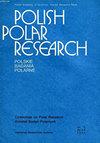南极土壤细菌群落结构、代谢适应及其对非生物因子的功能相互作用
IF 0.8
4区 地球科学
Q4 ECOLOGY
引用次数: 1
摘要
本文章由计算机程序翻译,如有差异,请以英文原文为准。
Soil bacterial community structure, metabolic adaptations and their functional interactions to abiotic factors in Antarctica
: Antarctica features one of the most ancient, largest glacier reserves and the most pristine environment left on the earth. However, in the last few decades disturbances due to industrialization and release of greenhouse gases have led to serious consequences such as melting of polar ice sheets, changing atmospheric chemistry and ozone depletion. Here, we use high-throughput sequencing to understand the impact of subtle changes in environmental parameters on bacterial communities. We observed dominance of Cyanobacteria (41.93%) followed by Bacteroidetes (14.8%), Acidobacteria (13.35%), Proteobacteria (9.67%), Actinobacteria (7.79%), Firmicutes (3.46%) among all the samples collected every alternate day for 20 days. Additionally, metagenomic imputations revealed a higher abundance of gene families associated with DNA repair and carotenoid biosynthesis enabling bacterial communities to resist and function under the high UV radiations. We further observed bacterial communities are dependent on the single carbon metabolism as a strategy for nutrient uptake in such nutrient deprived conditions.
求助全文
通过发布文献求助,成功后即可免费获取论文全文。
去求助
来源期刊

Polish Polar Research
ECOLOGY-GEOSCIENCES, MULTIDISCIPLINARY
CiteScore
2.00
自引率
7.70%
发文量
0
审稿时长
>12 weeks
期刊介绍:
The quarterly Polish Polar Research edited by the Committee on Polar Research of the Polish Academy of Sciences is an international journal publishing original research articles presenting the results of studies carried out in polar regions.
All papers are peer-reviewed and published in English.
The Editorial Advisory Board includes renowned scientist from Poland and from abroad.
 求助内容:
求助内容: 应助结果提醒方式:
应助结果提醒方式:


